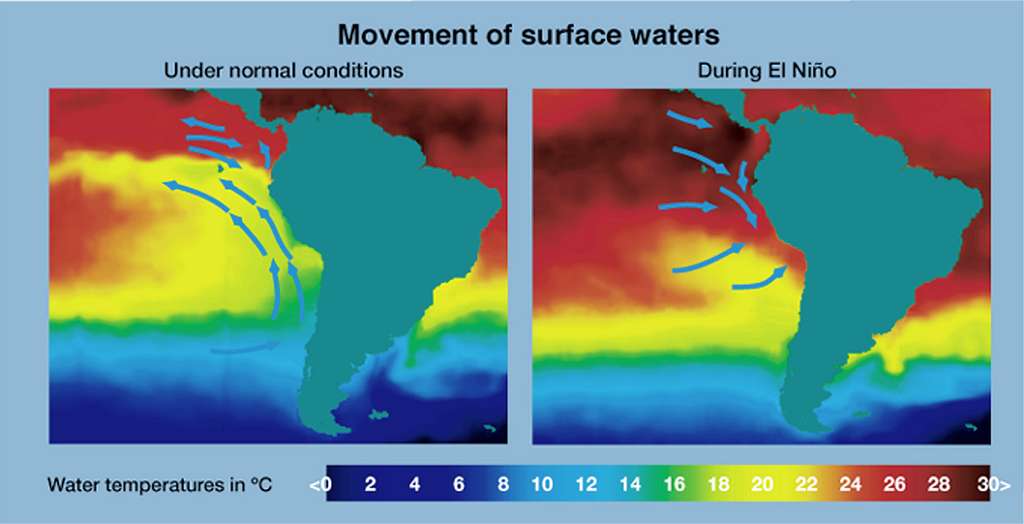Understanding El Niño and La Niña: Impacts on Global Weather Patterns
El Niño and La Niña, naturally occurring climate patterns originating in the tropical Pacific Ocean, have far-reaching effects on weather patterns worldwide. These phenomena, collectively known as the El Niño-Southern Oscillation (ENSO), influence temperature, precipitation, and atmospheric circulation, leading to a cascade of impacts on ecosystems, agriculture, and human societies.
The Science Behind ENSO:
Under normal conditions, trade winds blow westward across the tropical Pacific, pushing warm surface waters towards Indonesia and Australia. This allows cooler water to upwell along the coast of South America. However, during El Niño events, these trade winds weaken or even reverse, causing warm water to spread eastward towards the central and eastern Pacific. Conversely, during La Niña, trade winds strengthen, intensifying the upwelling of cool water in the eastern Pacific and pushing warm water westward.

Impacts of El Niño:
- Warmer Global Temperatures: El Niño events are typically associated with a rise in global average temperatures, as the release of heat from the tropical Pacific warms the atmosphere.
- Altered Precipitation Patterns: El Niño can cause increased rainfall in the southern United States and parts of South America, while leading to drier conditions in Indonesia, Australia, and Southeast Asia.
- Increased Hurricane Activity: The warmer waters in the central and eastern Pacific during El Niño can fuel hurricane formation in the eastern Pacific basin and reduce hurricane activity in the Atlantic basin.
Predicting and Monitoring ENSO:
Impacts of La Niña:
- Cooler Global Temperatures: La Niña events tend to have a cooling effect on global temperatures, as the upwelling of cool water in the eastern Pacific influences atmospheric circulation.
- Droughts and Floods: La Niña can exacerbate drought conditions in the southwestern United States and South America, while leading to increased rainfall and flooding in Australia, Indonesia, and Southeast Asia.
- Active Hurricane Seasons: La Niña often corresponds with increased hurricane activity in the Atlantic basin due to reduced wind shear and favorable atmospheric conditions.
Scientists use a variety of tools, including sea surface temperature measurements, satellite observations, and computer models, to monitor and predict El Niño and La Niña events. While ENSO is a natural cycle, understanding and predicting its phases is crucial for preparing for potential impacts on agriculture, water resources, and disaster management.
Impacts on Society and the Environment:
El Niño and La Niña can have significant socioeconomic and environmental consequences. Droughts and floods can impact agricultural yields, leading to food insecurity and economic losses. Changes in ocean temperatures can disrupt marine ecosystems, affecting fish populations and coastal communities.
Specific Examples of El Niño and La Niña Impacts on Countries:
El Niño Impacts:
- Peru and Ecuador: El Niño can bring heavy rainfall and flooding to these coastal nations, causing landslides, infrastructure damage, and disruptions to fishing industries due to warmer ocean temperatures. The 1997-98 El Niño event led to devastating floods and economic losses in both countries.
- Indonesia and Australia: El Niño often results in drier conditions and increased risk of wildfires in these regions. The 2015-16 El Niño contributed to severe droughts and widespread forest fires in Indonesia, causing significant air pollution and economic damage.
- Southern United States: El Niño can lead to wetter winters in California and the southern US, alleviating drought conditions but also increasing the risk of flooding and mudslides.
La Niña Impacts:
- East Africa (Kenya, Somalia, Ethiopia): La Niña typically exacerbates drought conditions in East Africa, leading to crop failures, food insecurity, and water scarcity. The 2010-11 La Niña event contributed to a severe famine in Somalia.
- Australia: La Niña often brings above-average rainfall and increased flooding to eastern Australia. The 2010-11 La Niña event resulted in widespread flooding in Queensland, causing significant damage to infrastructure and agriculture.
- Southeast Asia (Thailand, Vietnam, Philippines): La Niña can lead to increased rainfall and flooding in Southeast Asia, impacting rice production and increasing the risk of landslides and other natural disasters.
El Niño’s Influence:
- Hurricanes: El Niño typically suppresses hurricane activity in the Atlantic basin. The increased wind shear in the upper atmosphere during El Niño disrupts the formation and intensification of hurricanes. This means fewer hurricanes make landfall along the US East Coast and Gulf Coast during El Niño years.
- Tornadoes: The relationship between El Niño and tornadoes in the US is complex and varies regionally. Some studies suggest El Niño can lead to increased tornado activity in the Gulf Coast states during winter and spring, while potentially reducing tornado occurrences in the Great Plains during spring.
La Niña’s Influence:
- Hurricanes: La Niña often creates favorable conditions for hurricane development in the Atlantic basin. The reduced wind shear and warmer sea surface temperatures provide the necessary ingredients for hurricane formation and intensification. This can lead to more frequent and stronger hurricanes impacting the US East Coast and Gulf Coast during La Niña years.
- Tornadoes: La Niña can influence tornado activity in the US, particularly in the spring months. The stronger jet stream and increased wind shear associated with La Niña can create a more conducive environment for tornado formation in the Great Plains and Midwest.
